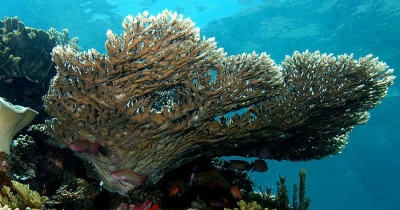
A major coral reef area of India, the Gulf of Mannar comprises as many as 21 islands and spans an area of 10,500 sq.km. This large shallow bay lies between the southeastern tip of India and the west coast of Sri Lanka. In addition to the coral reefs, this marine ecosystem includes salt marshes, algae communities, mangroves, and sea grasses too. One of the world’s richest regions of marine biodiversity, it faces threats such as climate change, pollution, coastal development, coral mining and mechanised fishing.
A marine biosphere reserve, this region houses over 1,100 species of fish, 800 species of molluscs, 150 species of anthropods, five species of turtles, over 10 species of snakes, and seven types of marine mammals. The marine creatures include starfish, crabs, sharks, seahorses, barracudas, dolphins, sea turtles such as olive ridleys and green turtles, whales, dugongs, sea cucumbers and otters. In addition to these, a variety of birds such as seagulls, plovers, curlews, and terns too can be spotted in the region.
Algal bloom concerns
In September 2019, the Reef Research Team of the Suganthi Devadasan Marine Research Institute reported that algal bloom had killed more than 180 coral reef colonies in Shingle Island located within the Gulf of Mannar Marine National Park. The death of the corals came to light after the fisherfolk in Ramanathapuram (located near the Gulf of Mannar) witnessed the sea water having turned green and the death of fish in thousands. Scientists from the National Centre for Coastal Research (NCCR) confirmed that the algae Noctiluca scintillans had bloomed. However, it was found that the nearby island of Krusadai was not impacted by the algal bloom. While climate change causes algal bloom, affecting corals and creatures such as fish, there was speculation if this incident was caused by ballast water. Ballast water is the water used in ships, especially cargo ships when they are empty, to help them with stability. This water carries several types of organisms. When the water is emptied into a region different from where it was collected, the organisms in it could cause negative ecological impacts on their habitat.
And some good news!
While COVID-19 has cost livelihoods and lives, and changed lifestyles globally, the pandemic is not without a few positives. The lockdown has had an especially positive impact in the context of ecology. And that is evident on the coastal ecosystems of the Gulf of Mannar along Thoothukudi district, according to newspaper reports. While collecting data for a State government project, the Suganthi Devadasan Marine Research Institute inThoothukudi conducted a study between May 25 and June 2 and discovered “a remarkable reduction” in the macro and meso-plastic pollution levels in many coastal locations in the region. The study also showed an “increase in the number of species of coral reef fishes from 89 in February to 96 in May”, at the Thoothukudi group of islands of Gulf of Mannar. It is said that fish normally migrated in the summer due to high population showed a spike, “thanks to less human disturbance during the lockdown period”.
Picture Credit : Google
